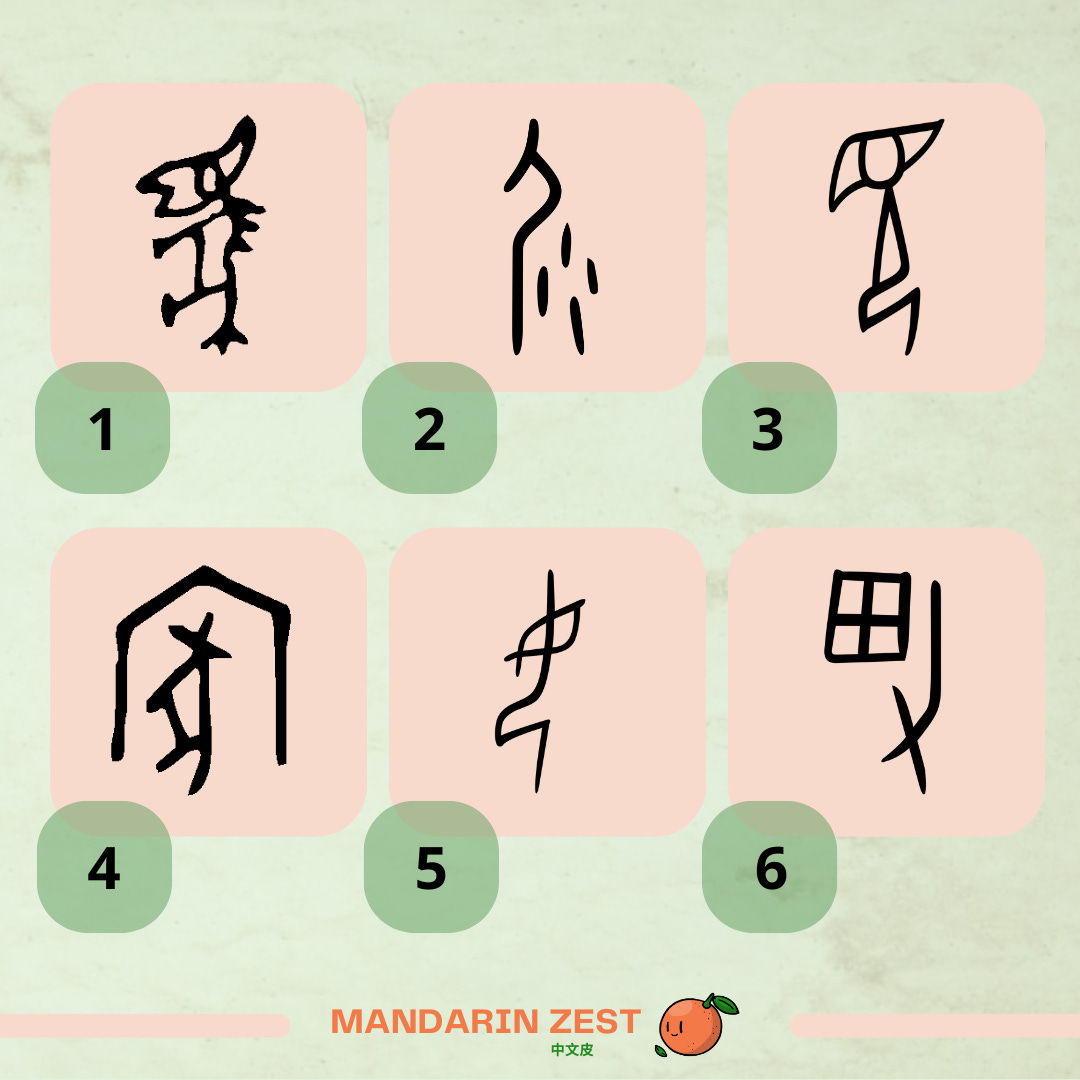Let's Read Ancient Chinese Characters
A quick dive into the world of the oracle bone script 🦴
The Chinese characters are a wonderful treasure in the history of mankind. We are all studying their modern forms, either simplified or traditional.
However, have you ever wondered how they looked like thousands years ago? What is more, some of them didn’t change much, and still carry their original meaning!
Let’s explore the fascinating beginnings of the Chinese characters: the oracle bone script and how to read it!
什么叫做「甲骨文」?
甲骨文是用刀子刻划或用毛笔书写在「甲」或「骨」上的一种古代文字。甲骨是占卜用的工具。 「甲」指龟甲,多用龟的腹甲,也有用背甲的。根据学者研究,商代占卜用的龟甲,大多来自南方。 「骨」是胛骨,多用牛的胛骨,特别是圣水牛的肩胛骨为供应卜骨的主要来源。骨的来源主要由当地供应,多是已被豢养或驯服的动物。最早出土于河南省安阳市殷墟,距今约3600多年的历史。
甲骨文 (Jiǎgǔwén) - oracle bone script, the oldest attested form of written Chinese, dating to the late 2nd millennium BC.
刻划 (kè huà) - to carve; synonyms: 雕刻 (diāo kè), 刻印 (kè yìn)
毛笔 (máobǐ) - a writing brush
占卜 (zhānbǔ) - a divination
龟甲 (guījiǎ) - a tortoise shell
腹甲, 背甲 (fù jiǎ, bèi jiǎ) - plastron (tortoise belly shell), carapace (tortoise back shell)
商代 (Shāng dài) - Shang Dynasty, the earliest dynasty of traditional Chinese history firmly supported by archaeological evidence. Modern scholarship dates the dynasty between the 16th and 11th centuries BC.
圣水牛 (shèng shuǐniú) - “sacred buffalo”, a now extinct short-horned water buffalo that lived in ancient China
肩胛骨 (jiānjiǎgǔ) - a shoulder blade
供应 (gōngyìng) - to supply
豢养 (huànyǎng) - to feed (lifestock)
驯服 (xùnfú) - to tame
你现在要对你驯服过的一切负责到底。《小王子》- You become responsible, forever, for what you have tamed. “Little Prince”
殷墟 (Yīnxū) - Yinxu, lit. “Ruins of Yin”, a Chinese archeological site corresponding to Yin, the final capital of the Shang dynasty, located in present-day Anyang, Henan.
Oracle bone script is an ancient form of writing that was carved with a knife or written with a brush on "shells" or "bones." These shells and bones were tools used for divination. "Shells" refer to turtle shells, primarily the plastrons (the flat underside), though carapaces (the domed back) were also used. According to scholars, most of the turtle shells used for divination during the Shang dynasty came from the south.
"Bones" refer to scapulae, mainly those of oxen, with the scapulae of sacred water buffaloes being the primary source for divination bones. These bones were mainly supplied locally and typically came from domesticated or tamed animals. The earliest oracle bones were unearthed in Anyang, Henan Province, at the site of the Yin Ruins, dating back over 3,600 years.
Would you be able to recognise these characters in their ancient form?
从甲骨上的文字看,它们已具备了中国书法的用笔、结字、章法三要素。其用笔线条严整瘦劲,曲直粗细均备,笔画多方折,对后世篆刻的用笔用刀产生了影响。从结构字体上看,文字不仅有变化,虽大小不一,但比较均衡对称,还显示了稳定的格局。因此从章法上看,虽受骨片大小和形状的影响,仍表现了镌刻的技巧和书写的艺术特色。
结字 (jiézì) - a word, a character formation
章法 (zhāngfǎ) - a composition (of words, things)
线条 (xiàntiáo) - lines, strokes
严整 (yánzhěng) - strict, in this context: neat
瘦劲 (shòu jìn) - thin
曲直 (qūzhí) - curvy and straight
粗细 (cūxì) - thick and thin
均备 (jūn bèi) - equipped (here referring to the characters being equipped with different types of strokes)
多方折 (duōfāng zhé) - multifold; synonym: 多种趋势 (Duō zhǒng qūshì)
后世 (hòushì) - later generations
篆刻 (zhuànkè) - seal carving
均衡对称 (jūnhéng duìchèn) - a balanced symmetry
镌刻 (Juānkè) - to engrave, an engraving
From the writing on the oracle bones, we can see that they already possessed the three essential elements of Chinese calligraphy: brushstrokes, character structure, and composition. The brushstrokes are precise and strong, with variations in curves and thickness, and many angular turns, influencing later seal carving techniques. In terms of structure, the characters exhibit variety; although they differ in size, they are relatively balanced and symmetrical, displaying a stable arrangement. Therefore, even though the size and shape of the bone fragments influenced the composition, the engravings still demonstrate skilled carving techniques and the artistic characteristics of calligraphy.
Let’s Play!
Look at these oracle bone characters and try to guess their modern form, either simplified or traditional (if you know the traditional script, too). Scroll down for answers.
Ready?
1…
2…
3…
Let’s see the anwers!
马 (馬):字形像马头、马鬃、马尾、四足的造型。
屎:像屈起屁股的人的臀部位置,加了几点指事符号,表示从肛门排出的排泄物。
见(見):注视,监督。见的甲骨文是 [目+人],眼睛在观察。
家:甲骨文=(宀,房屋)+(豕,猪),像屋里养着一头大腹便便的猪。
女:甲骨文像一个屈膝跪坐的人娴静地交叠着双手。
男:甲骨文=(田,田野)+(力,体力),是主外、开荒耕种的劳动主力。
马鬃 (mǎzōng) - horsehair
屈起 (qū qǐ) - to bend
屁股 (pìgu) - butt, bottom
臀部 (túnbù) - hips
肛门 (gāngmén) - anus
排泄物 (páixiè wù) - extrements
注视, 监督 (zhùshì, jiāndū) - watch, supervise
大腹便便 (dàfùpiánbiàn) - a big belly
屈膝跪坐 (qūxī guì zuò) - bend knees and kneel
娴静 (xiánjìng) - gentle and refined
交叠 (jiāo dié) - overlap, fold; 交叠着双手 - folding one’s hands
开荒 (kāihuāng) - land reclamation (agriculture)
耕种 (gēngzhòng) - cultivation (agriculture)
马 (馬): The character resembles the shape of a horse's head, mane, tail, and four legs.
屎: This character looks like the buttocks of a person squatting, with added dots to indicate excrement being expelled from the anus.
见 (見): Means to observe or supervise. The oracle bone script for "见" is a combination of [eye + person], indicating an eye observing.
家: The oracle bone script for "家" is a combination of (宀, house) + (豕, pig), representing a pig being raised inside a house.
女: The oracle bone script for "女" resembles a person kneeling with their legs tucked under and hands crossed in a calm manner.
男: The oracle bone script for "男" is a combination of (田, field) + (力, physical strength), symbolizing the primary labor force for farming and clearing land.
Can you write your name as oracle bone script? You should try!
Antoine & Dorota






